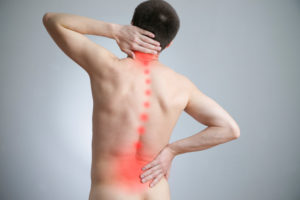 Degenerative Disc Disease is the term used to describe the natural deterioration of the discs in the spine. This condition does not affect every person, but it does occur in a relatively high percentage of the population. The two areas of the spine in which degeneration is commonly seen are the neck and the low back. When pain persists and a patient is told he has degenerative disc disease, there may be a misperception that the affected segment of the spine will continually degrade until surgery is necessary. This isn’t the case. Here, we want to discuss a few ways that the structures that buffer pressure in the spine can be nurtured to decrease the severity of wear and tear.
Degenerative Disc Disease is the term used to describe the natural deterioration of the discs in the spine. This condition does not affect every person, but it does occur in a relatively high percentage of the population. The two areas of the spine in which degeneration is commonly seen are the neck and the low back. When pain persists and a patient is told he has degenerative disc disease, there may be a misperception that the affected segment of the spine will continually degrade until surgery is necessary. This isn’t the case. Here, we want to discuss a few ways that the structures that buffer pressure in the spine can be nurtured to decrease the severity of wear and tear.
Activity Helps Your Spine
Back and neck pain are interesting because, when you have one or the other (or both), you may not feel much like engaging in the same level of physical activity you have in the past. While a temporary time out to rest and rejuvenation can be beneficial, this shouldn’t continue for long. Staying active is one of the best things we can do for spine health.
When we exercise, we increase the circulation of blood and oxygen through the body, including into the discs of the spine. This is crucial not only to prevention but also to healing and management. The better blood and nutrients can flow to the discs, the more likely these structures are to maintain hydration and pliability. We also cannot overlook the fact that physical exercise, even walking, causes a release of endorphins in the brain – and endorphins are natural pain-reducers.
If you have been diagnosed with degenerative disc disease, talk with your doctor or physical therapist about appropriate exercise to maximize benefits to the spine.
Watch your Posture
The positive and the negative must both be addressed in order to manage the state of the spine. Where exercise is a positive step, posture can work against the intended benefits. Therefore, it is vital to look at how your posture may be putting you at risk. Consider actions such as changing positions every few minutes if you sit for long periods of time. Add a support pillow to your chair to prevent low back strain. If your job requires you to lift, do so with proper body mechanics. If you’re not sure what posture is appropriate for lifting, contact a physical therapist for guidance. Finally, the mattress you sleep on should allow you to wake up feeling restored, not sore. If you suspect your mattress is not supporting the natural curves of your spine while you sleep, look for a new one.
Dr. Albert is a renowned NYC spinal surgeon who provides personal care to patients in need of pain relief. For more information on our services, call 212-606-1004.

